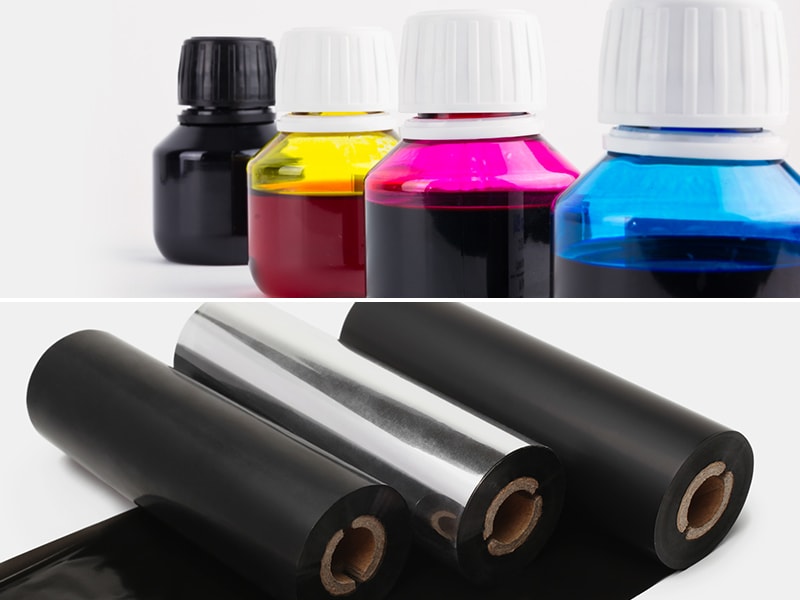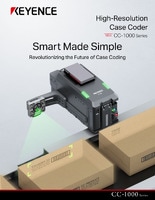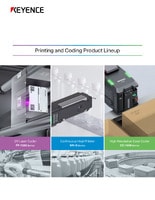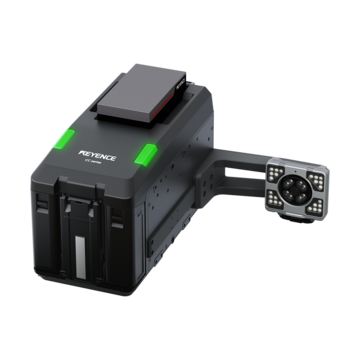Continuous Inkjet Printers / Case Coder
Materials and Products
Production Machines
Printing Applications
Oil-Based vs. Wax-Based Ink in Large Character Inkjet Printing
Key Takeaways
- Oil-based ink outperforms wax on porous substrates (corrugated, paperboard) with sharper, durable codes.
- Oil-based systems eliminate warm-up delays and reduce unplanned downtime and maintenance.
- Oil-based printers use less energy and produce fewer consumables, easing operational costs and waste.
- CC-1000 Series pairs oil chemistry with long‑throw nozzles, automated cleaning, high resolution and inspection camera.

In large character inkjet applications, the choice of ink chemistry directly impacts print quality, uptime, and printer maintenance cost.
Wax-based printers have long been used for packaging and coding; however, their limitations create challenges in modern high-volume environments. Oil-based ink, as used in the CC-1000 Series, has become the more reliable option for porous substrates like cardboard cartons, offering stable performance where speed and clarity are critical and supporting cost-effective printing solutions for manufacturers.
Why Oil-Based Ink Is the Superior Choice for Large Character Printing
Oil-based inks are designed with production realities and reliability in mind. For porous substrates such as corrugated boxes and paperboard, oil-based formulations provide strong, legible codes without the drawbacks of wax. These inks maintain stability in the printhead, support high-resolution inkjet printing, and avoid the startup delays associated with solid inks.
In high-speed environments, reliability is the deciding factor. Oil-based inks work in drop-on-demand large character inkjet systems, producing consistent lot codes, barcodes, and text. Print quality is not compromised by smudging or heating requirements, and the chemistry holds up under varying ambient conditions. For manufacturers focused on uptime and clarity, oil-based solutions have become the go-to for busy production lines.
We’re here to provide you with more details.
Reach out today!

Challenges with Wax-Based Ink: Maintenance and Reliability Issues
Wax-based printers can cover both porous and non-porous surfaces, but that flexibility comes at a cost. The systems require heating elements to liquify solid wax pucks, and startup often takes 30 to 40 minutes. If the heater fails, repair costs rise sharply, leaving the printer idle and unusable until service is performed.
Even when operational, wax-based systems present maintenance challenges. Heat cycling accelerates wear on components, and wax buildup around printheads demands frequent cleaning. These added tasks drive up printer maintenance costs and cut into available production time. In fast-moving industries, extended warm-up and recurring downtime are major liabilities.
Energy use is another drawback. Keeping wax melted consumes more power, and that added overhead shows up in total operating expense. Combined with the risk of smudging and limited durability under moisture or abrasion, wax-based printing creates ongoing reliability concerns for production teams.
Comparative Analysis: Oil-Based vs. Wax-Based Ink
Oil-based ink shows its strength on porous materials like corrugated cartons because its prints appear immediately, without a heating cycle, and remain sharp even under fast-moving production. The CC-1000 Series builds on this by combining oil-based chemistry with high-resolution inkjet printing, producing large characters and codes that stay legible throughout distribution.
Wax-based printers, by contrast, introduce delays and added complexity. They can run on a broader set of substrates, but startup takes time, and the heating process creates additional wear on components. Operators often find themselves stopping the line to deal with buildup or to service the heating element.
Oil-Based Ink: Advantages and Applications
Oil-based ink has become a staple in porous packaging lines where speed and reliability matter most. In food and beverage production, cartons carry expiration dates that need to stay legible even after cold storage and transport. Pharmaceutical distribution depends on clear serialization printed directly onto corrugated cases so that products can be tracked at every checkpoint. Automotive and chemical suppliers often move goods through long supply chains, and clear case codes prevent mix-ups as shipments move from plant to warehouse.
What ties these industries together is the need for stable, high-resolution inkjet printing without constant intervention. With oil-based systems, operators avoid long cleaning routines and don’t need to wait for heating cycles. The result is uninterrupted coding on cartons and boxes, with fewer stoppages and lower printer maintenance costs.
Curious about our pricing?
Click here to find out more.

Understanding Ink Compatibility with Different Surfaces in Industrial Printing
Not every substrate behaves the same when ink is applied, and this is where the choice between oil-based ink vs. wax-based ink matters most. Corrugated cartons, kraft paper, and other porous packaging materials absorb liquid quickly, allowing oil-based formulations to settle into the fibers. This absorption creates durable marks that don’t smudge during handling or distribution, even when cases are stacked tightly on pallets or exposed to vibration during shipping. Operators in packaging plants often prefer oil-based systems because they can switch between different carton grades (double wall, recycled board, or lightweight corrugate) without worrying about adhesion loss or blurred codes.
For operations printing on corrugated shipping cases or paper-based packaging, oil-based ink is the logical match. It balances print quality with stability and avoids the added downtime that wax requires. Large character inkjet printers paired with the right chemistry maintain throughput while delivering consistent, legible codes.
How Oil-Based Ink Improves Printer Efficiency and Reduces Downtime
Unplanned stoppages are costly on any line. Wax-based printers add to the problem with long warm-up cycles and recurring maintenance tied to wax buildup. Each restart eats into production time, and repeated delays add up quickly.
Oil-based printing avoids these slowdowns. With no heating element, the system is ready to run as soon as the line starts. The CC-1000 Series builds on this with a long throw distance that limits nozzle clogging, automated cleaning functions, and an inspection camera that verifies codes without manual checks.
Together, these features keep production steady and lower printer maintenance costs, letting teams stay focused on throughput instead of constant intervention.
The Environmental and Operational Benefits of Oil-Based Ink
Wax printers draw more power because their heaters must stay on to keep the wax melted, which adds to energy bills over time. Oil-based systems avoid that extra load by running at room temperature, and the reduced strain means less industrial inkjet printer maintenance for operators.
From an environmental perspective, wax ribbons and pucks create added waste while oil-based cartridges generate less waste and require fewer consumables. In regulated industries such as food and pharma, oil-based inks formulated without mineral oils also support safer compliance, reducing the risk of migration into packaging layers.
Choosing the Right Ink for Your Printing Needs
Ink selection depends on more than just print quality. Substrate type, production speed, and ongoing maintenance all factor into the decision. Wax-based printers cover a wider range of surfaces, but that flexibility carries trade-offs: long warm-up cycles, higher service demands, and heavier energy use.
For porous packaging lines, oil-based systems avoid those hurdles. Case coders like our CC-1000 Series deliver high-resolution inkjet printing on cartons and cases, hold up through shipping and storage, and keep printer maintenance costs low. In plants where uptime is critical, the CC-1000 Series gives production teams a cost-effective printing solution that supports consistent output shift after shift.
Switch to oil-based ink for a reliable, low-maintenance solution. Learn more about the CC-1000 Series today!
Contact us to learn more about how our advanced technology can help take your business to the next level.
Contact Us
FAQs
What Makes Oil-Based Ink More Cost-Effective Than Wax-Based Ink in the Long Run?
Oil-based printers start without delay and need less upkeep, which lowers ongoing costs. Wax printers often take longer to get running and can rack up expensive repairs when heating parts fail.
Can the CC-1000 Series Handle Both Porous and Non-Porous Materials with Oil-Based Ink?
The CC-1000 Series’ oil-based ink is formulated for porous materials such as corrugated cardboard and cartons; for these substrates, it provides durable, clear marks without downtime. Non-porous applications are better suited to other chemistries.
How Does the CC-1000 Series Support Higher Printing Efficiency Compared to Wax-Based Systems?
By eliminating warm-up cycles and reducing buildup around the printhead, the CC-1000 Series minimizes interruptions. Its automated cleaning and built-in inspection features cut down on industrial inkjet printer maintenance, helping maintain line speed without the extended stoppages common to wax printers.
We’re here to provide you with more details.
Reach out today!

Related Downloads
Related Products
Applications
Materials and Products
- Glass Bottles
- Plastic Bottles/Containers
- Cans
- Wires, Cables, & Pipes
- Pouches
- Metal Parts
- Corrugate Boxes
- Packaging Film
- Kraft Packaging
- Folding Cartons
- Building Materials
- PCBs
- Cartons
- Pallets & Lumber
- Corrugate Trays
Production Machines
- Paper Bag Packaging
- Box Conveyor
- Automatic Palletizer
- Sealer/Taping Machine
- Bottle Filling Machine
- Flow Wrapper





